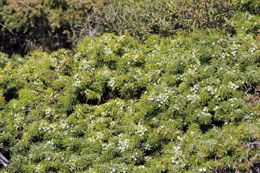Juniper shrubs are mainly used for landscaping because of their beautiful foliage. Read the following Buzzle article to know more.

These shrubs and bushes are quite hardy and can grow in any soil. They're also resistant to drought and can grow well even if there is less rainfall or water shortage. Some junipers grow as trees, while some of them grow parallel to the ground as landscaping shrubs, providing excellent ground cover. Some of the junipers also bear berries that are used as flavoring agents in various types of dishes.
Types
There are many juniper shrubs varieties that come in various sizes and shapes. Here are some popular varieties of junipers that can be found adorning public gardens as well as in some homes. Some of these are varieties of flowering bushes and shrubs.
- Alligator Juniper
- Ashe Juniper
- Bermuda Juniper
- Blanco's Juniper
- Blue Chip Juniper
- Blue Pacific Shore Juniper
- Blue Point Juniper
- Blue Rug Juniper
- Blue Star Juniper
- Blue Weeping Juniper
- Broadmoor Juniper
- Buffalo Juniper
- California Juniper
- Coahuila Juniper
- Comitán Juniper
- Creeping Juniper
- Durango Juniper
- Eastern Juniper
- Gamboa Juniper
- Gold Coast Juniper
- Gold Lace Juniper
- Hollywood Juniper
- Jalisco Juniper
- Mexican Weeping Juniper
- Mountain Juniper
- One-seed Juniper
- Pinchot Juniper
- Rocky Mountain Juniper
- Saltillo Juniper
- Sierra Juniper
- Southern Juniper
- Spartan Juniper
- Spiral Juniper
- Utah Juniper
- West Indies Juniper
- Western Juniper
- Wichita Blue Juniper
Instructions for Pruning
Pruning a shrub or a bush will keep a check on unnecessary growth and keep the plant in a desired shape. Never water in excess as it may damage the plant; water only after it has been planted. This will assist in establishing roots and growing. Since juniper shrubs can grow at a rapid pace, they should be pruned on a routine basis.
- The best time to prune is from late winter to early spring. This is the time when the flowering varieties don't bear flowers.
- With the help of pruning shears, remove the dead, broken, and diseased branches. Make sure that you don't cut more than five or six affected branches at one go.
- The junipers are a variety of fast-growing shrubs. Branches growing oddly or intertwining with others need to be trimmed till the base, since they can hamper the healthy growth of the plant. The top of the juniper should be shaped in such a way that the top branches are shorter than those near the ground. Shaping them in this manner will ensure that the entire shrub receives ample sunlight.
- While pruning, exercise proper precaution to cut only the green growth. Cutting the woody part is not advised since it may not regrow. Also, protect your plant from pests.
Growing these varieties in combination with other evergreen shrubs and hedges will add an elegant touch of beauty to your garden, with its well-pruned branches. For a more stunning and attractive landscaping, you can prune these bushes in varied shapes.






 These shrubs and bushes are quite hardy and can grow in any soil. They're also resistant to drought and can grow well even if there is less rainfall or water shortage. Some junipers grow as trees, while some of them grow parallel to the ground as landscaping shrubs, providing excellent ground cover. Some of the junipers also bear berries that are used as flavoring agents in various types of dishes.
These shrubs and bushes are quite hardy and can grow in any soil. They're also resistant to drought and can grow well even if there is less rainfall or water shortage. Some junipers grow as trees, while some of them grow parallel to the ground as landscaping shrubs, providing excellent ground cover. Some of the junipers also bear berries that are used as flavoring agents in various types of dishes.